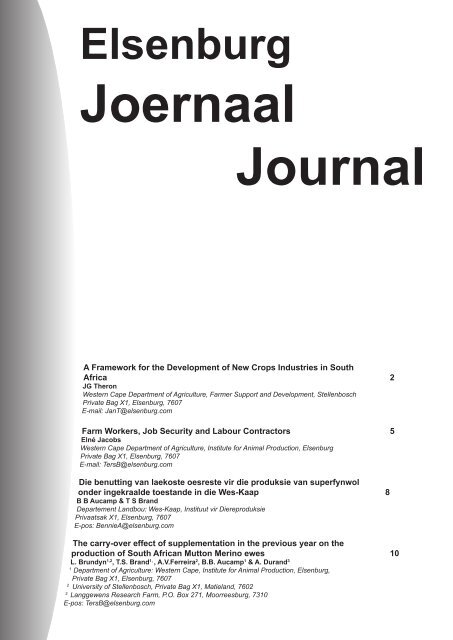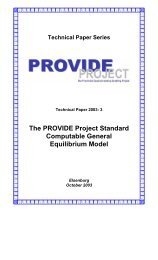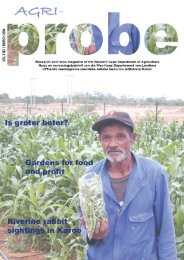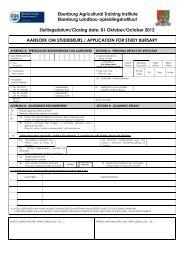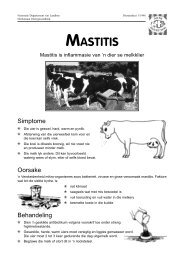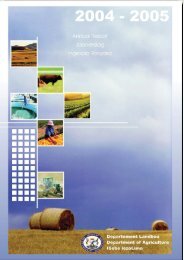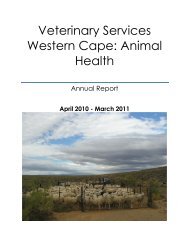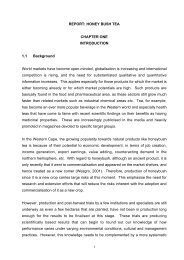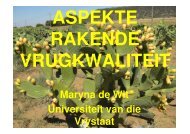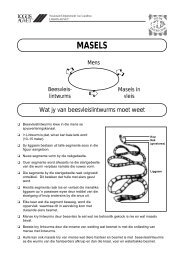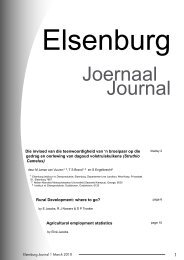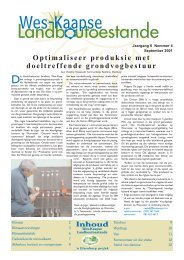Download Elsenburg Joernaal/Journal - Department of Agriculture ...
Download Elsenburg Joernaal/Journal - Department of Agriculture ...
Download Elsenburg Joernaal/Journal - Department of Agriculture ...
Create successful ePaper yourself
Turn your PDF publications into a flip-book with our unique Google optimized e-Paper software.
1<br />
<strong>Elsenburg</strong><br />
<strong>Joernaal</strong><br />
<strong>Journal</strong><br />
A Framework for the Development <strong>of</strong> New Crops Industries in South<br />
Africa 2<br />
JG Theron<br />
Western Cape <strong>Department</strong> <strong>of</strong> <strong>Agriculture</strong>, Farmer Support and Development, Stellenbosch<br />
Private Bag X1, <strong>Elsenburg</strong>, 7607<br />
E-mail: JanT@elsenburg.com<br />
Farm Workers, Job Security and Labour Contractors 5<br />
Elné Jacobs<br />
Western Cape <strong>Department</strong> <strong>of</strong> <strong>Agriculture</strong>, Institute for Animal Production, <strong>Elsenburg</strong><br />
Private Bag X1, <strong>Elsenburg</strong>, 7607<br />
E-mail: TersB@elsenburg.com<br />
Die benutting van laekoste oesreste vir die produksie van superfynwol<br />
onder ingekraalde toestande in die Wes-Kaap 8<br />
B B Aucamp & T S Brand<br />
Departement Landbou: Wes-Kaap, Instituut vir Diereproduksie<br />
Privaatsak X1, <strong>Elsenburg</strong>, 7607<br />
E-pos: BennieA@elsenburg.com<br />
The carry-over effect <strong>of</strong> supplementation in the previous year on the<br />
production <strong>of</strong> South African Mutton Merino ewes 10<br />
L. Brundyn1,2 , T.S. Brand1, , A.V.Ferreira2 , B.B. Aucamp1 & A. Durand3 1 <strong>Department</strong> <strong>of</strong> <strong>Agriculture</strong>: Western Cape, Institute for Animal Production, <strong>Elsenburg</strong>,<br />
Private Bag X1, <strong>Elsenburg</strong>, 7607<br />
2 University <strong>of</strong> Stellenbosch, Private Bag X1, Matieland, 7602<br />
3 Langgewens Research Farm, P.O. Box 271, Moorreesburg, 7310<br />
E-pos: TersB@elsenburg.com<br />
<strong>Elsenburg</strong> <strong>Journal</strong><br />
2008 (2)
A Framework for the Development<br />
<strong>of</strong> New Crops Industries<br />
in South Africa<br />
J.G. Theron<br />
Western Cape <strong>Department</strong> <strong>of</strong> <strong>Agriculture</strong>, Farmer Support and Development, Stellenbosch<br />
Introduction<br />
The grain industry (mainly maize and wheat) is the largest crop<br />
industry in South Africa under rain-fed conditions. Significant<br />
changes have taken place since deregulation in agriculture and<br />
the termination <strong>of</strong> subsidies from mid 1990s. The total area<br />
under grain has decreased by about 10% to 15% (C. Du Plessis,<br />
pers. commun. 2001) due to lower prices (based on import<br />
parity and free market forces) and the higher risk <strong>of</strong> production<br />
because <strong>of</strong> the absence <strong>of</strong> state subsidies. Consequently, grain<br />
planting has decreased significantly on low potential land as<br />
well as on high potential land in remote areas.<br />
In future, global market forces will test the viability <strong>of</strong> all agricultural<br />
commodities being produced in South Africa. <strong>Agriculture</strong><br />
is still an important part <strong>of</strong> the national economy and greatly<br />
influences rural economy. Diversification or substitution by new<br />
crops could provide opportunities to improve the viability <strong>of</strong> the<br />
agricultural sector per se. This would be the case where the<br />
production <strong>of</strong> commodities or other established industries, have<br />
become non-competitive. However, the development <strong>of</strong> most<br />
new industries or businesses is usually complicated because<br />
<strong>of</strong> the high risks involved. It is therefore necessary to develop<br />
guidelines, frameworks, and processes to improve the success<br />
rate <strong>of</strong> new agricultural industries.<br />
There are examples <strong>of</strong> successful new crop industries<br />
established in South Africa. One is the canola industry in the<br />
Western Cape Province. It has grown from virtual no industry<br />
since early 1990s, to a production area <strong>of</strong> 30,000 ha currently,<br />
with two processing plants in place (B.F. Saaiman, pers. commun.<br />
2001). This development is significant in a South African<br />
context.<br />
The roots <strong>of</strong> this industry started with a contract Canadian<br />
researcher. His instruction was research on alternative crops<br />
for the wheat industry in the Western Cape Province. Canola<br />
proved to be the best alternative <strong>of</strong> crops tested. It was first<br />
considered for a domestic niche market. Farmers started to produce<br />
in small quantities and the crop was pressed at an existing<br />
oilseed company. The production <strong>of</strong> canola increased to such<br />
an extent that this plant could not handle the supply. Consequently,<br />
two plants were erected by agricultural co-operatives.<br />
This was not done simultaneously, but only after the capital<br />
investment was justified by regional levels <strong>of</strong> canola production.<br />
At present research is being carried out on uneven germination<br />
that poses a barrier to the growth <strong>of</strong> the industry (A.J. van W.<br />
Conradie, pers. commun. 2001).<br />
Factors in new <strong>Agriculture</strong> Industries<br />
Janick (1999) classified food crops on the basis <strong>of</strong> their economic<br />
importance. Major crops are cultivated worldwide in<br />
adapted areas with high economic value and are associated<br />
with high genetic input. They include grains, forages, oilseeds<br />
and grain legumes, tuber crops, fruits, vegetables, and sugar<br />
crops. Speciality crops are niche crops that, while economically<br />
important, have small markets that can be filled by a relatively<br />
few growers. Included are a number <strong>of</strong> horticultural species including<br />
fruit, vegetable, and spice crops. Under-utilised crops<br />
were once more widely grown but are now falling into disuse<br />
for various agronomic, genetic, economic, or cultural factors. In<br />
<strong>Elsenburg</strong> <strong>Joernaal</strong><br />
2008 (2)<br />
general, they are characterized by much less genetic improvement<br />
than the major crops but they are being lost because they<br />
are less competitive. Examples include cereals such as emmer<br />
and spelt; pseudocereals such as buckwheat; and oilseeds<br />
such as sesame and safflower. Neglected crops, traditionally<br />
grown in their centers <strong>of</strong> origin and where they are important<br />
for the subsistence <strong>of</strong> local communities, are maintained by<br />
socio-cultural preferences and traditional uses. These crops remain<br />
inadequately characterised and, until recently, have been<br />
largely ignored by agricultural researchers and genetic conservation.<br />
Yet they may represent our most valuable potential<br />
resource for the future. In some cases, their lack <strong>of</strong> exploitation<br />
is an historical accident. Examples include the Andean root and<br />
tuber crops, and the minor millets such as Panicum, Paspalum,<br />
and Digitaria species. New crops include those recently<br />
developed from wild species whose virtues are newly discovered,<br />
formerly collected <strong>of</strong> wild-crafted species, or synthesized<br />
crops created from interspecific or intergeneric crosses. They<br />
represent only a handful <strong>of</strong> cultivated species and very few are<br />
included as new foods. Totally new crops from wild species are<br />
mainly associated with industrial crops such as Limnanthes alba<br />
(meadow foam), a source <strong>of</strong> unique seed oils, or Taxus brevifolia,<br />
a source <strong>of</strong> Taxol ® , a valuable anticarcinogen. Genetically<br />
transformed crops include those modified by recombinant<br />
DNA technology. Gene splicing is now an established technique<br />
with over 50 transgenic crops field-tested in the United States.<br />
Rates <strong>of</strong> adoption by farmers for transgenic cotton, soybean,<br />
and maize have been very high from the first releases in 1996.<br />
When new crop industries are promoted it is important to<br />
make use <strong>of</strong> acquired experience, knowledge, and wisdom.<br />
There are many pitfalls to avoid and numerous risk factors to be<br />
managed. McKinna (1999) has identified critical success factors<br />
in new agricultural industries (Table 1). The two most critical<br />
factors on the list are capital availability and an effective market<br />
development plan.<br />
Pasqual (1995), stressed the importance <strong>of</strong> a market driven<br />
approach to new crop selection. She further stated that the<br />
identification <strong>of</strong> crop opportunities with good prospects relies on<br />
ascertaining their demand by overseas consumers. A database<br />
has been developed and the following limits were placed in<br />
order to avoid duplication: (1) each product is unique in the<br />
database—there is only one entry for each type <strong>of</strong> product; (2)<br />
price information is limited to retail prices, (3) availability <strong>of</strong> a<br />
product in a certain country may not necessarily mean it is in<br />
demand, (4) fresh product information is limited to the season<br />
covered by the market survey; and (5) food products in demand<br />
by the food service sector and exotic or medicinal food preparations<br />
are not covered.<br />
It is clear that development <strong>of</strong> new crop industries is basically<br />
the creation <strong>of</strong> new business opportunities. Risk is one<br />
factor that needs special attention in this regard. The reason for<br />
this is that new crop industries are usually considered higher<br />
risk enterprises than conventional crop farming. Future trading<br />
(market), financial (economic), physical (production) and social<br />
(personal and management) environments are more likely to<br />
be unknown and thus it is more difficult to generate the pr<strong>of</strong>it<br />
outcomes sought (Buffier 1998).<br />
2
Krause (1996), recommended the following steps when new<br />
crop business opportunities are evaluated: (1) do a risk audit or<br />
develop a risk pr<strong>of</strong>ile; (2) develop a business plan with goals,<br />
objectives, budgets and cash flows; (3) use financial modeling<br />
<strong>of</strong> cash flows to examine the impact <strong>of</strong> different events occurring;<br />
(4) calculate the pr<strong>of</strong>itability using appropriate measures<br />
such as npv (net present value) and irr (internal rate <strong>of</strong> return);<br />
(5) look at the risk/reward ratio relative to the level <strong>of</strong> risk that<br />
is acceptable; and (6) understand the “fall-back” position if the<br />
venture fails.<br />
Industries or companies based on raw materials from<br />
agriculture differ distinctly from other business in one particular<br />
aspect; it is depended on agricultural production. Selection <strong>of</strong><br />
new crops is not an easy task because a whole range <strong>of</strong> factors<br />
has to be considered. A checklist for the selection <strong>of</strong> new crops<br />
has been published in the Australian New Crops Newsletter<br />
(1998). The shortened list <strong>of</strong> criteria only as far as crops directly<br />
are concerned is: botanical/geographical, agronomic, production,<br />
production economics, domestic production, and funding <strong>of</strong><br />
domestic research.<br />
Proposed structural framework for the development<br />
<strong>of</strong> new crop industries<br />
A simplified, holistic outline <strong>of</strong> the main elements for the development<br />
<strong>of</strong> new crops industries is proposed in Fig. 1. It is an<br />
attempt to provide an organisational framework for use in different<br />
situations. Thus an individual intending to take advantage<br />
<strong>of</strong> a niche market, or a company wanting to implement vertical<br />
integration, could make use <strong>of</strong> these basic principles, which are<br />
essentially the same for all market entrants. The different seg-<br />
Table 1. Critical success factors in new agricultural industries.<br />
3<br />
Factor Most important elements<br />
ments <strong>of</strong> the value chain in Fig. 1 indicate domestic or foreign<br />
contributions to the total chain. For example, if a product for a<br />
sophisticated market is produced, it might be expected that only<br />
the agricultural part <strong>of</strong> the value chain would be done locally.<br />
There are therefore possibilities for strategic alliances and partnerships<br />
depending on specific situations. Where resources are<br />
limited, as is the case in South Africa, co-operation at all levels<br />
with local and foreign partners is crucial. Successful implementation<br />
requires attention to establishment <strong>of</strong> goals (Table 2) for<br />
each element in the value chain.<br />
References<br />
1. Alvaro Altuve, G. 2001. Notes on the development <strong>of</strong> SMME’s<br />
in the Western Cape. Unpublished.<br />
2. Buffier, B.D. 1999. Will your venture pay? Austral. New Crops<br />
Newslet. 11. www.newcrops.uq.edu.au/newslett/ncnl11-4.<br />
htm<br />
3. Janick, J. 1999. New crops and the search for new food resources.<br />
p. 104–110. In: J. Janick (ed.), Perspectives on new<br />
crops and new uses. ASHS Press, Alexandria, VA.<br />
4. Krause, M.A. 1999. Will your venture pay? Austral. New<br />
Crops Newslet. 11. www.newcrops.uq.edu.au/newslett/<br />
ncnl11-4.htm.<br />
5. MacKinna, D.A. 1999. Critical success factors and strategic<br />
issues in new agricultural enterprises. Austral. New Crops<br />
Newslet. 11. www.newcrops.uq.edu.au/newslett/ncnl11-2.<br />
htm.<br />
6. New Crops Criteria Check List. 1998. Austral.<br />
New Crops Newslet. 9. www.newcrops.uq.edu.au/<br />
newslett/ncnl9-7.htm.<br />
7. Pasqual, G. 1995. Market driven approach to new crop selection.<br />
Austral. New Crops Newslet. 4.<br />
An effective industry association Effective chief executive with good supporting staff.<br />
Expertise in finance, legal, marketing, business management, technical production, agropolitics and<br />
government relations.<br />
Full support from the industry with adequate representation<br />
Adequate finance and financial mechanisms and structures<br />
Adequate funding for the commercial stage New industries must have sufficient capital to finance infrastructure, systems and research and development.<br />
Capital is required up front with the prospect <strong>of</strong> not being repaid for more or less five years.<br />
An efficient production capability The new industry must be pr<strong>of</strong>itable in the light <strong>of</strong> what is usually formidable global competition and<br />
hence must strive for world’s best practice in production.<br />
Farms must be able to maintain their commercial viability as farm gate prices decline.<br />
Genetic material are at an early stage <strong>of</strong> evolution with growth, yields, and quality <strong>of</strong>ten low to that <strong>of</strong><br />
the traditional industries.<br />
An efficient processing and value-added<br />
capability<br />
A market driven product specification and<br />
quality assurance regime<br />
Establishing appropriate technology and production systems usually by adapting technologies from<br />
other industries.<br />
Skills development <strong>of</strong> the labor force.<br />
Achieving economic output levels <strong>of</strong> the value adding plant.<br />
The key quality/performance specifications for a new product need to be determined, along with quality<br />
assurance procedures that the quality and performance <strong>of</strong> the product and its suitability for predict<br />
various end users. Hence, standards must be developed.<br />
Quality compliance might become too difficult for some producers.<br />
Selling outside the system results in the undermining <strong>of</strong> prices and return.<br />
An effective trading/distribution mechanism The economy <strong>of</strong> distribution is heavily driven by volume. A strategic alliance is recommended with organizations<br />
which distribute complementary but not non-competitive products to same customer base<br />
An effective market development program With new products the market is very thin; it only takes 5 to 10 tonnes <strong>of</strong> oversupply to flood the market<br />
and cause prices to free fall.<br />
Lack <strong>of</strong> funding. Market development activity, particularly promotion, is quite expensive and usually<br />
requires activity both locally and overseas.<br />
Product availability. Market development activities need to occur to create demand before the product<br />
becomes available for consumers to buy. Such activities can be restricted by a lack <strong>of</strong> product, including<br />
the problem <strong>of</strong> not having samples for prospective customers.<br />
A brand oriented marketing and promotional<br />
strategy<br />
Branding is a proven marketing tool. If done well, branding will generate brand loyalty and premium<br />
returns and will give an industry a greater degree <strong>of</strong> control over the market channel.<br />
Branding is more than labeling a product. It needs to be underpinned by a strong marketing strategy<br />
and culture, committed to quality.<br />
<strong>Elsenburg</strong> <strong>Journal</strong><br />
2008 (2)
<strong>Elsenburg</strong> <strong>Joernaal</strong><br />
2008 (2)<br />
Factor Most important elements<br />
The ability to dispose <strong>of</strong> all products at<br />
economically viable levels<br />
Managing the transition from speculative<br />
(the stage where pioneers foresee a huge<br />
commercial potential and start to interest<br />
others, who may be driven by an interest in<br />
capital gains and tax deductions) to commercial<br />
stage.<br />
An adequate funded and well run R&D<br />
function<br />
Product markets usually have no difficulty in disposing <strong>of</strong> the top quality product at a high return.<br />
All industries inevitably produce a certain percentage <strong>of</strong> lower quality/less preferred product, regardless<br />
<strong>of</strong> their commitment to quality and this product must be disposed <strong>of</strong> satisfactorily.<br />
There is a role for government in regulating the speculative stage. At the very least, it should tighten<br />
up the requirement for prospectuses on new enterprises.<br />
There is a need to ensure that potential investors or participants are well informed about what they<br />
are getting into, for instance the long-term prospects and critical success factors.<br />
New industries need research and development on several fronts: on farm production; product description<br />
and quality; processing and value adding; product performance; transportation and distribution;<br />
and market research and intelligence.<br />
One <strong>of</strong> the key roles <strong>of</strong> the industry association is to identify R&D priorities and to ensure that the<br />
funding and expertise are in place.<br />
Effective dealing with bioethical issues New agricultural industries are likely to face novel bioethical issues which the industry associations<br />
must be ready to deal with effectively as they arise.<br />
Table 2. Implementation <strong>of</strong> new crops: goals to achieve.<br />
Element Requirement<br />
World market • Competent strategic management<br />
• Market driven approach where consumer needs are most important<br />
• Knowledge <strong>of</strong> possible markets<br />
• Availability <strong>of</strong> detailed market information<br />
• Market information continuously updated and stored<br />
<strong>Agriculture</strong> • Crop selection basis (potential adaptability, productivity, and target market), complexity <strong>of</strong> production,<br />
availability <strong>of</strong> effective pesticides and herbicides, harvesting process and technology available, information<br />
and research backup, state <strong>of</strong> economy in present agricultural industry, capital requirements,<br />
compatibility with present agricultural activities and technology in use, risks involved, environmental<br />
implications, social acceptability)<br />
• Cost effective transportation <strong>of</strong> raw materials is in place<br />
• New crops promoted only after development <strong>of</strong> a business plan<br />
• Efficient growers association in place<br />
Processing industry • Matching processing plant development (capital requirement) and agricultural production (volumes)<br />
• Adaptation <strong>of</strong> existing technology to reduce initial cost<br />
• Risk management in place<br />
• Effective co-operation and communication<br />
• Cost effective and economical production<br />
• Products continuously produced according to the minimum standards required by the market<br />
• Standards are in place, strictly according to market preference<br />
• New products can be developed<br />
Retailers and other service providers • Services needed to sell products are in place; outlets, promotion, market development, and distribution<br />
Other important aspects • Competent strategic management is conducted (business development)<br />
• Efficient services for every part <strong>of</strong> the value chain exist<br />
• Research & development for every part <strong>of</strong> the value chain is in place<br />
Fig. 1. Elements <strong>of</strong> new crop development. Shaded boxes indicate local<br />
activity (adapted from Alvaro Altuve 2001).<br />
4
5<br />
Farm Workers, Job Security<br />
and Labour Contractors<br />
Elné Jacobs<br />
Western Cape <strong>Department</strong> <strong>of</strong> <strong>Agriculture</strong>, Agricultural Economics<br />
Abstract<br />
Labour contractors’ involvement in the Agricultural sector has<br />
increased recently due to a variety <strong>of</strong> reasons. There is the<br />
technological change that makes production more expensive<br />
and the legal ambiguities that present opportunities for labour<br />
contractors. Labour contractors provide cheaper, seasonal employment<br />
to farmers, taking the legislative responsibility away<br />
from the farmer. But the Standard Employment Act <strong>of</strong> South<br />
Africa does not cover this three-tiered relationship between<br />
farmer, labour contractor and farm worker, causing widespread<br />
concern over the use <strong>of</strong> unregulated labour contractors. Labour<br />
Force Survey results suggest a move away from permanent<br />
workers within the Western Cape Agricultural sector towards<br />
more seasonal employment and casualisation and one case<br />
study suggests the unfair treatment <strong>of</strong> farm workers employed<br />
by unregulated labour contractors. This paper investigates the<br />
available information on employment trends and labour contractor<br />
involvement, and the effect it has on farm workers.<br />
Introduction<br />
The South African labour market, and especially the agricultural<br />
sector, has been characterized by a recent trend towards<br />
seasonal employment and casualisation is a consequence <strong>of</strong><br />
this movement. Labour Force Surveys indicate the decrease in<br />
permanent larbour within the sector, suggesting a move towards<br />
more seasonal employees. Van der Burg (2008:6) holds the<br />
flexibility and openness <strong>of</strong> the sector responsible for this occurrence.<br />
Globalisation, technological innovation and import<br />
and export increases have created a trend towards temporary<br />
employment <strong>of</strong>fered by labour contractors. Conradie (2006:1)<br />
argues that falling farm pr<strong>of</strong>its and rising cost <strong>of</strong> production has<br />
caused farm owners to move away from permanent farm workers,<br />
using labour contractors to minimize cost and responsibility,<br />
and to increase production. Another reason given by Conradie<br />
(2006: 7) for this move towards casualisation is that <strong>of</strong> the passing<br />
<strong>of</strong> the Extension <strong>of</strong> Security <strong>of</strong> Tenure Act (Act 62 <strong>of</strong> 1997).<br />
This Act provides that households who live on farms may not be<br />
unlawfully evicted and the conditions <strong>of</strong> unlawful evictions are<br />
stated. But farmers perceived this law as giving farm workers<br />
permanent rights to their land (Conradie 2006:9). Employers<br />
thus tried to distance themselves from permanent workers and<br />
started using labour contractor services for casual and seasonal<br />
employees.<br />
Regardless <strong>of</strong> the cause, an opening in the market<br />
emerged, and labour contractors stepped forward. Labour<br />
contractors provide farmers temporary employment, taking the<br />
legislative responsibility away from farmers. For the farmer it’s<br />
a winning situation: He does not have to employ permanent<br />
workers and thus pay wages all year round due to legal duty<br />
and he gets employment in times <strong>of</strong> need. But farm workers are<br />
being marginalised in the process. There is no job security and<br />
no provision is made in the legal framework <strong>of</strong> the Standard<br />
Employment Act <strong>of</strong> South Africa. The most vulnerable are thus<br />
more vulnerable.<br />
The Western Cape Agricultural sector has been no exception<br />
to the rule, and labour contractors are increasingly visible<br />
throughout the province. Conradie (2006:1) states that the<br />
seasonal employment (especially on fruit and wine farms) is<br />
widespread in the Western Cape, and although Conradie does<br />
not report on labour contractor activity, it implies that labour<br />
contractors have more than enough opportunity for business<br />
prospects. Barrientos and Kritzinger (2004) claims that in a<br />
global economy, outsourcing is the norm, especially in export<br />
agriculture.<br />
It can be argued that a mixture <strong>of</strong> environmental factors,<br />
such as globalization and technology, and legal loopholes presented<br />
opportunities for farmers and farm workers to separate,<br />
giving rise to labour contractors. The next section presents the<br />
results form the Labour Force Surveys from 2000 till 2007 to<br />
prove the incline in seasonal workers. Labour contractors will<br />
then be defined together with notes on the potential impact it<br />
has on farmers and farm workers. Case Studies will be referred<br />
to throughout the discussion. The last section investigates the<br />
legal gaps presented by the South African Employment Act<br />
in order for better understanding to make recommendations.<br />
Conclusions and recommendations are made from the provided<br />
information.<br />
Evidence <strong>of</strong> Labour Force Surveys<br />
Every year since 2000, in March and September, Statistics<br />
South Africa conducted the Labour Force Survey in order to<br />
gain information from the labour force regarding demographic<br />
indicators. One <strong>of</strong> the questions that was asked <strong>of</strong> respondents<br />
(only the employed) was that <strong>of</strong> the terms <strong>of</strong> employment. Respondents<br />
had to classify whether their work were permanent,<br />
a fixed period, temporary, casual or seasonal (Statistics South<br />
Africa). Full time workers according to Statistics South Africa,<br />
are employees that work an agreed number <strong>of</strong> hours (normally<br />
more than 40 hours a week) in a particular occupation, whereas<br />
part-time employees work less than 40 hours a week. Permanent<br />
workers are those who have a job with no set termination<br />
date, while a fixed period worker have a contract for more than<br />
a year but with a set termination date. Temporary workers, as<br />
defined by Statistics South Africa, are workers that are appointed<br />
on a short-term contract basis, normally shorter than a year,<br />
and excluding the self-employed. Casual workers are workers<br />
that do not fall within the permanent or temporary classification<br />
and works on an hourly or daily basis. Also, they are not entitled<br />
to employee benefits such as medical aid or Unemployment<br />
Insurance (Statistics South Africa). Seasonal workers are not<br />
distinctly defined differently from casual workers, but Statistics<br />
South Africa does record both seasonal and casual workers for<br />
analysis purposes. This creates uncertainty <strong>of</strong> measurement<br />
within these two categories.<br />
The following figure represents the findings for this question<br />
regarding the Western Cape Agricultural workers:<br />
Only the March survey <strong>of</strong> every year was taken into account.<br />
There is clearly an increase and then a reduction in permanent<br />
employment, while the fixed period employment remains fairly<br />
stable. A case study done by Conradie (2006) reveals that<br />
more than 50% <strong>of</strong> farmers in the Hex River Valley have cut<br />
their permanent workforce since 1998 and 40% more reveals<br />
that they planned to cut even further. Temporary employment<br />
decreased slightly whereas casual employees increased since<br />
<strong>Elsenburg</strong> <strong>Journal</strong><br />
2008 (2)
2003. Seasonal employment increased considerably (from<br />
26 000 to 39 000 workers) which might indicate that workers<br />
moved from permanent and temporary employment towards<br />
seasonal employment. This is more visible in the 2006 and<br />
2007 data, where permanent and seasonal employment is<br />
mirror images <strong>of</strong> each other. Investigating the employment<br />
figures with regards to race, the following pattern occurs:<br />
Above figure indicates that employment within the agricultural<br />
sector decreased steadily since 2000, but this was<br />
due to mainly Coloured workers leaving the sector. Quantec<br />
(Consultancy) total employment data were compared<br />
to Labour Force data, and a similar trend is recognized.<br />
Taking into consideration both figures, seasonal employment<br />
increased in spite <strong>of</strong> overall decreases in employment.<br />
There is thus evidence that some <strong>of</strong> the permanent worker<br />
decrease is accounted for by the seasonal worker increase,<br />
but the overall decrease suggests that more workers leave<br />
the agricultural sector than workers joining it. The increase<br />
in seasonal workers might be explained by workers without<br />
any other means <strong>of</strong> income, and therefore accepting the<br />
terms <strong>of</strong> the seasonal employment standards. One thing is<br />
for sure: Seasonal workers increased and permanent workers<br />
decreased, creating the current opportunities for labour<br />
contractor involvement.<br />
Labour Contractors<br />
According to Wikipedia (online), a contractor is an agent,<br />
“one that acts on behalf <strong>of</strong> a principal”. In <strong>Agriculture</strong>, a<br />
labour contractor is the mediator between farmer and<br />
farm worker. The farmer does not want to employ permanent<br />
workers, for various reasons, and uses contractors<br />
to provide them with workers if need be. Contractors in<br />
turn employ workers to work on farms where they as<br />
contractors get work contracts. This seems like an ideal<br />
situation, farmers benefit from attaining workers to fulfil<br />
their requirements, and farm workers can live where they<br />
want to, and work on different farms. Farm workers therefore<br />
can get all the amenities <strong>of</strong> living in the urban areas,<br />
but still work on farms.<br />
But labour contractors are unregulated in most <strong>of</strong> South<br />
Africa, and not covered in the legal framework 1 . Due to<br />
this unregulated design, data for labour contractors and<br />
labour contractor involvement is limited. Two case studies<br />
were done from 2006 to investigate the casualisation <strong>of</strong><br />
workers and labour contractor’s participation in the process.<br />
The first study was conducted by Conradie in 2006 at the Hex<br />
River Valley grape farms. Casualisation, as part as employment<br />
trends, were analysed and results included that the reallocation<br />
<strong>of</strong> permanent workers to seasonal workers in other fruit farms<br />
were not visible in the case study. There was a steady decline in<br />
employment, but this was due to technological change and not<br />
legislative changes relating to land and labour. The composition<br />
<strong>of</strong> the workforce also did not change dramatically. Concluding<br />
from the case study is that legalisation is not always the cause<br />
<strong>of</strong> casualisation, but it may contribute towards the process.<br />
The Extension <strong>of</strong> Security <strong>of</strong> Tenure Act (Act 62 <strong>of</strong> 1997) is an<br />
example <strong>of</strong> such contribution from legislation. More reliable<br />
data is also needed for measuring casualisation. Data collection<br />
needs to be sensitive to the irregular work conditions <strong>of</strong> <strong>of</strong>f-farm<br />
seasonal workers in order to record consistent employment patterns.<br />
The question <strong>of</strong> the employment strategy from the farmer<br />
remains puzzling and it seems that it depends on the farmer’s<br />
perception <strong>of</strong> the economic state <strong>of</strong> affairs and authoritarian<br />
environment.<br />
The second case study was conducted by the Centre<br />
for Legal Rural Studies and Women on Farms Project in the<br />
Grabouw area between November 2007 and February 2008.<br />
Findings concluded that seasonal workers and permanent work-<br />
1 See next section for detailed discussion<br />
<strong>Elsenburg</strong> <strong>Joernaal</strong><br />
2008 (2)<br />
Number <strong>of</strong> Workers<br />
300,000<br />
250,000<br />
200,000<br />
150,000<br />
100,000<br />
50,000<br />
0<br />
Figure 1: Work Status <strong>of</strong> the Western Cape Agricultural Workforce<br />
from 2000 till 2007 Source: Own Calculations out <strong>of</strong><br />
Labour Force Survey’s 2000-2007<br />
Employment figures for Western Cape Agricultural Workforce<br />
2000 2001 2002 2003 2004 2005 2006 2007<br />
Total<br />
Quantec<br />
African/Black<br />
Coloured<br />
White<br />
Figure 2: Employment data for Western Cape Agricultural<br />
Workforce from 2000 till 2007 Source: Own Calculation from<br />
Labour Force Survey’s 2000-2007 and Quantec Data (2008)<br />
ers do not receive the same benefits; only permanent workers<br />
are likely to receive benefits; transportation and accommodation<br />
<strong>of</strong> seasonal workers are troublesome; there is no clarity <strong>of</strong> who<br />
the employer is, some say the farmer, others say the contractor;<br />
seasonal workers are not registered for Unemployment<br />
Insurance or Workmen’s compensation or belong to a union;<br />
and some element <strong>of</strong> child labour was detected. Workers were<br />
paid under the minimum wage and only work certain days, the<br />
principle <strong>of</strong> no work no pay applies. They are also paid by performance,<br />
which mean the physically stronger or more efficient<br />
worker get paid more, making it difficult for women to ensure<br />
a better income. Migrant workers dominate (64% were from<br />
Transkei) because the contracts <strong>of</strong>fered by the building sector<br />
provides better pay to local workers. 75% <strong>of</strong> labour contractors<br />
also do not have any knowledge <strong>of</strong> the labour law <strong>of</strong> South Africa<br />
and they work from their homes. Their conclusions from the<br />
case study is that casualisation gives rise to the employment<br />
figures <strong>of</strong> seasonal and migrant workers which in turn creates<br />
an unstable and unfair labour market where the legal framework<br />
<strong>of</strong> South Africa have no reach.<br />
These two case studies indicate that casualisation is on the<br />
rise, and labour contractors are using the opportunity presented<br />
to them. Because <strong>of</strong> the unregulated environment, farm workers<br />
6
might experience unfair treatment.<br />
Legislative ambiguities<br />
The South African legal framework is based on the standard<br />
employment relationship where employment is fulltime, a<br />
designated workplace is assigned and an employee contract<br />
exists. This two-tier affiliation does not include a third party like<br />
a labour contractor (Theron J. 2007:4). This employee contract<br />
does provide for temporary workers, but temporary workers<br />
usually are employed on the basis <strong>of</strong> filling in for another<br />
worker on maternity leave or during a busy season. Temporary<br />
Contract <strong>of</strong> Employment is a contract between the agency<br />
and employer and no relationship exist between the worker<br />
and employer (Basic Conditions <strong>of</strong> Employment Act <strong>of</strong> 1997,<br />
<strong>Department</strong> <strong>of</strong> Labour). Again only a two-tier relationship exists.<br />
Casual workers are defined within the legislation as anyone<br />
who works within the informal sector or a formal sector employee<br />
with a temporary, seasonal or casual contract. The key word<br />
contained by the formal sector is that <strong>of</strong> a contract.<br />
The casual worker is therefore not fully covered by the<br />
standard employment relationship due to its definition (Van der<br />
Burg A. 2008:17). Firstly casual workers do not have fulltime<br />
employment and their workplace does not cater for labour<br />
contractor involvement. The workplace differs as the labour<br />
contractor moves from farm to farm. Due to the two-tier relationship,<br />
a contract only exists between employer and employee,<br />
which begs the question: In the farm worker – labour contractor<br />
– farmer connection, who is the employer and who is the<br />
employee? Usually there will only exist a contract between the<br />
farmer and labour contractor, leaving the farm worker exposed.<br />
Therefore casual workers do not qualify for standard employee<br />
benefits such as social security and bonuses (Van der Burg A.<br />
2008:13). The current legal framework also does not cater for<br />
labour contractor registration and regulation, leaving the labour<br />
contractors to do as they wish.<br />
These legislative gaps provide a background for non-equitable<br />
practices within the Agricultural sector; open for exploitation<br />
by anyone who wants to avoid the legislative lags that are<br />
associated with <strong>of</strong>ficial procedures.<br />
Conclusion<br />
Labour right’s violations in the <strong>Agriculture</strong> sector in South Africa<br />
is on the rise due to the use <strong>of</strong> unregulated labour contractors<br />
(Van der Burg 2008:2). Casualisation <strong>of</strong> farm workers cause a<br />
three-tier relationship with the farm worker, labour contractor<br />
and farmer as key players, but this relationship is not covered<br />
within the legal framework. Only a two-tier relationship is covered,<br />
and usually the farmer and labour contractor abide to the<br />
legal regulations, leaving the farm worker legally exposed. Farm<br />
workers, without written contracts, hence have no standard<br />
employee advantages. The most vulnerable are thus pushed<br />
further into defencelessness, causing widespread concern over<br />
the use <strong>of</strong> unregulated labour contractors. Legislation such as<br />
the <strong>of</strong> Security <strong>of</strong> Tenure Act (Act 62 <strong>of</strong> 1997) also caused farmers<br />
to reduce their permanent workforce, creating farm workers<br />
without written contracts and job security. But it is not only the<br />
legal gaps that caused this occurrence, but the ever-changing<br />
environment <strong>of</strong> the global economy. Rising technological advances<br />
and import-export requirements cause lower prices and<br />
higher factor cost. The labour contractor provides farmers with a<br />
cheaper option <strong>of</strong> employment without legal formalities.<br />
A case study done in the Western Cape Province indicated<br />
that labour contractors are worsening the fate <strong>of</strong> seasonal<br />
workers, however another indicate that legal obscurities are not<br />
always to blame for casualisation. Data from Statistics South<br />
Africa’s Labour Force Surveys indicate that there was indeed a<br />
significant increase in seasonal employment, indicating that the<br />
overall trend suggest a move away from permanent employment.<br />
Whether this is because <strong>of</strong> labour contractors or technological<br />
advances, more exploration into the subject is needed to<br />
7<br />
make accurate conclusions.<br />
Nevertheless, there is evidence that labour contractors’<br />
involvement is greater than ever, but this brings the next question<br />
to mind: How to improve the position farm workers are<br />
currently facing? Labour legislation can change, but operational<br />
factors are more difficult. Recommendations from these findings<br />
include the revision <strong>of</strong> the South African labour law to ensure<br />
the three-tier relationship is covered within the legal framework,<br />
making sure realistic ways <strong>of</strong> enforcing legislation are found,<br />
and labour contractors must be regulated to ensure registration<br />
<strong>of</strong> workers for benefits received by permanent workers such<br />
as the Unemployment Insurance Fund. With the increased use<br />
<strong>of</strong> labour contractors, better transport facilities for the workers<br />
and women rights need to be scrutinised to ensure a fair labour<br />
market. There is also a need for thorough research into possible<br />
models which might help the fate <strong>of</strong> the most vulnerable in in<br />
the agricultural sector.<br />
References:<br />
1. Barrientos, S. & Kritzinger, A. (2004). Squaring the circle:<br />
Global production and the in formalisation <strong>of</strong> work in South<br />
African fruit exports. <strong>Journal</strong> <strong>of</strong> International Development,<br />
16:81-92<br />
2. Basic Conditions <strong>of</strong> Employment Act <strong>of</strong> 1997, <strong>Department</strong> <strong>of</strong><br />
Labour. Available online at: www.labour.gov.za<br />
3. Conradie, B. (2006). What do we mean when we say casualisation<br />
<strong>of</strong> farm work is rising?: Evidence from fruit &<br />
wine farms in the Western Cape. Presented at the 44 th Annual<br />
Conference <strong>of</strong> the Agricultural Economics Association<br />
<strong>of</strong> South Africa in Grahamstown, 20-22 September 2006.<br />
4. Quantec (2008) Quantec database, Wesgro , Cape Town<br />
Statistics South Africa: Labour Force Survey 2000 – 2007.<br />
Available online at; www.statssa.gov.za<br />
5. Theron, J. (2007). Atypical Employment in South Africa. Annual<br />
<strong>Department</strong> <strong>of</strong> Labour Seminar, p4<br />
6, Van Der Burg, A. (2008). Going for Broke: A case study <strong>of</strong><br />
Labour Brokerage on Fruit Farms in Grabouw. Research Report<br />
published by Centre for Rural Legal Studies, Stellenbosch<br />
2008.<br />
7. Wikipedia (2008). Available online at www.wikipedia.org<br />
<strong>Elsenburg</strong> <strong>Journal</strong><br />
2008 (2)
Die benutting van laekoste oesreste<br />
vir die produksie van superfynwol<br />
onder ingekraalde toestande in die<br />
<strong>Elsenburg</strong> <strong>Joernaal</strong><br />
2008 (2)<br />
Wes-Kaap<br />
B B Aucamp & T S Brand<br />
Western Cape <strong>Department</strong> <strong>of</strong> <strong>Agriculture</strong>, Institute for Animal Production, Western Cape<br />
Die belangrikste kwaliteitseienskap in die verwerkingsproses<br />
van wol is die gemiddelde veseldikte en daarom het dit ook die<br />
grootste invloed in die prysbepaling van wol (Rae, 1982). Naas<br />
die aanvanklike invloed wat genotipe op wolgroei het, is voeding<br />
die omgewingsfaktor wat die grootste invloed het op die<br />
groei van wolvesels, veral wat veseldikte betref (Reis, 1982). Dit<br />
is bekend dat beperkte <strong>of</strong> lae kwaliteit voeding ’n vermindering<br />
in veseldikte tot gevolg het. Dit behoort dus moontlik te wees<br />
om veseldikte te manupileer onder gekontroleerde voedingstoestande.<br />
Die kwaliteit en dus die prys wat wol behaal word ook<br />
negatief beïnvloed deur besoedeling met st<strong>of</strong> en plantmateriaal.<br />
Sonlig dra ook by tot die verwering van wolvesels (Reis, 1982).<br />
In die lig van die groot prys premie wat superfynwol behaal<br />
is ’n proef uitgevoer om te bepaal <strong>of</strong> veseldikte verminder kan<br />
word deur rantsoene wat ho<strong>of</strong>saaklik uit laekoste oesreste<br />
bestaan aan genetiese fynwol Merino skape te voorsien (groot<br />
hoeveelhede lae kwaliteit oesreste is in die Wes-Kaap beskik<br />
baar). Om die persentasie skoonopbrengs van die wol te<br />
verhoog is die proef onder ingekraalde toestande uitgevoer.<br />
Die ideaal is ook om die diere in goeie kondisie te hou. Indien<br />
’n verlaging in veseldikte moontlik is, het die proef ook verder<br />
ten doel gehad om die ekonomiese regverdigbaarheid van die<br />
praktyk te ondersoek, aangesien die rantsoene ’n vermindering<br />
in wolproduksie tot gevolg mag hê.<br />
Materiaal en metode<br />
Vyftig twee jaar oue fynwol Merino ooie afkomstig van die<br />
Grootfontein Merino stoet in die Oos-Kaap is ewekansig volgens<br />
liggaamsmassa in vyf groepe van tien elk verdeel. Die<br />
skape is elkeen afsonderlik in ’n hokkie op hortjiesvloere in ’n<br />
goed geventileerde gebou geplaas. ’n Midrib wolmonster vir<br />
veseldikte (VD) ontleding is van elke skaap geneem. ’n Rantsoen<br />
bestaande uit 50% lusernhooi en 50% koringstrooi is ad.<br />
lib. vir ’n aanpassings periode van een maand voorsien. Die<br />
vyf groepe het daarna die verskillende rantsoene soos in Tabel<br />
1 daagliks ad. lib. ontvang. Na ’n maand is die ooie geskeer<br />
om enige wolbreuke wat as gevolg van aanpassing op die lae<br />
kwaliteit rantsoen kon ontstaan te verwyder. Onmiddelik na<br />
skeer is ’n jas vir elke skaap aangesit. Liggaamsmassas is<br />
maandeliks bepaal en midrib wolmonsters is na ses maande<br />
en weer na 12 maande wolgroei geneem waarna die skape<br />
geskeer is en vagmassas bepaal is (onderlyne buite rekening).<br />
Die rantsoene is chemies ontleed vir totale as, ruproteïen<br />
soos beskryf deur die AOAC (1985) en suurbestandevesel en<br />
neutraalbestande vesel is beraam volgens die metodes van Van<br />
Soest (1963) en Van Soest en Wine (1967). Die in vitro verteerbare<br />
organiese materiaalinhoud is bereken volgens die metode<br />
van Tilley en Terry (1963).<br />
Die data van veseldiktes en liggaamsmassa is met behulp<br />
van analise van variansie statisties ontleed met behulp van<br />
ko-variante. Veseldiktes en liggaamsmassas met aanvang van<br />
proef was onderskeidelik die ko-variante.<br />
Veseldikte is deurmiddel van die OFDA metode deur die<br />
Woltoetsburo van S.A. bepaal.<br />
Resultate<br />
Die chemiese ontleding van die vyf rantsoene word in Tabel 2<br />
vertoon.<br />
In Tabel 3 word die produksie data van die vyf groepe skape<br />
vertoon. Die aanvanklike gemiddelde veseldikte van al die<br />
skape was 19,16µ. Die gemiddelde veseldikte van monsters<br />
van al vyf groepe was laer (15,4µ) na die 12 maande proefperiode.<br />
Die gemiddelde veseldikte na ses maande was 15,9µ. Die<br />
grootste verskil in veseldikte van die aanvang tot 12 maande<br />
wolgroei het in groep vyf (4,72µ) voorgekom. Die gemiddelde<br />
veseldikte van groep vyf (14,4µ) was betekenisvol laer as die<br />
van die in groepe een, twee en drie terwyl die van groepe een<br />
en twee betekenisvol hoër was as die van groepe vier en vyf.<br />
Groep twee het die kleinste verlaging in veseldikte (3,06µ)<br />
gehad.<br />
Die gemiddelde skoonwol opbrengs was 81,1% vir al die<br />
skape. Die gemiddelde skoonwolmassa van groepe een en<br />
twee was betekenisvol hoër as die van groepe drie, vier en vyf<br />
met groepe vier en vyf ook betekenisvol laer as groep drie.<br />
Die gemiddelde aanvanklike liggaamsmassa van al die<br />
skape was 39.2kg. Die endmassas van groep een en twee<br />
was hoër as die beginmassas terwyl groepe drie, vier en vyf se<br />
endmassas laer was as die beginmassas met groep vyf wat die<br />
grootste daling het.<br />
Groep een het ’n betekenisvolle hoë vrywillig rantsoen inname<br />
gehad as groep drie, vier en vyf.<br />
Gevolgtrekking<br />
Die lae kwaliteit dieet het wel ’n verlaging van die aanvanklike<br />
veseldiktes tot gevolg gehad. Die skape wat rantsoen vyf met<br />
die hoogste strooi inhoud en geen graan ontvang het, het die<br />
grootste verlaging in veseldikte en liggaamsmassa gehad asook<br />
die laagste gemiddelde wolmassa.<br />
Die chemiese ontleding van die rantsoen monsters toon<br />
geen noemenswaardige verskille in ruproteïen, vesel <strong>of</strong> organiese<br />
materiaal verteerbaarheid nie. Die diëte het egter verskil<br />
in terme van kwaliteit van proteïene sowel as vlak van die<br />
graankomponent wat ’n defnitiewe rol in voerkwaliteit sal speel.<br />
In Tabel 4 word slegs beraamde pryse vir veseldiktes van<br />
13 mikron tot 17 mikron gegee,aangesien wol met hierdie lae<br />
veseldiktes nie algemeen bemark word nie (Scott, 2001).<br />
Die gemiddelde opbrengs (R) van die ooie in die vyf groepe<br />
se wol word in Tabel 5 gegee. Uit die Tabel kan afgelei word<br />
dat, indien die vagte volgens veseldikte verpak en bemark sou<br />
word, groep een die hoogste inkomste sou lewer. Die laer vagmassas<br />
van skape in bv. groep vyf benadeel die prys voordeel<br />
wat deur die laer mikrons behaal kon word.<br />
Verwysings<br />
1. AOAC, 1985. Official methods <strong>of</strong> analysis (13 th Ed.). Association<br />
<strong>of</strong> <strong>of</strong>ficial analytical chemists, Inc. Arlingtong, Virginia,<br />
USA.<br />
2. RAE, A.L., 1982. Breeding. In: Sheep and goat production.<br />
Ed. I. E. Coop. World Animal Science. Production-system<br />
8
9<br />
Tabel 1: Rantsoen samesellings wat ad. lib. aan vyf groepe voorsien is.<br />
Bestandeel % Samestelling<br />
Gemaalde koring strooi<br />
Gars<br />
Melasse meel<br />
Ureum<br />
Vitamien & mineraal premix<br />
Dikalsiumfosfaat<br />
Sout<br />
Groep 1 Groep 2 Groep 3 Groep 4 Groep 5<br />
74.40<br />
20.00<br />
2.00<br />
1.40<br />
0.20<br />
1.20<br />
1.00<br />
79.20<br />
15.00<br />
2.00<br />
1.50<br />
0.20<br />
1.27<br />
1.00<br />
84.00<br />
10.00<br />
2.00<br />
1.60<br />
0.20<br />
1.35<br />
1.00<br />
Tabel 2: Chemiese samestelling van rantsoene (100% DM)<br />
approach. C.1. Elsevier Scientific Publishing Company. New<br />
York. Pp. 15-55.<br />
3. REIS, P.J., 1982. Growth and characteristics <strong>of</strong> wool and<br />
hair. In: Sheep and goat production. Ed. I.E. Coop. World<br />
Animal Science. Production-system approach. C.1. Elsevier<br />
Scientific Publishing Company. New York. Pp. 205-223.<br />
4. SCOTT, R., 2008. Persoonlike mededeling. BKB, Eppingdust.<br />
5. TILLEY, J.M. & TERRY, R.A., 1963. A two-stage technique for<br />
88.90<br />
5.00<br />
2.00<br />
1.70<br />
0.20<br />
1.42<br />
1.00<br />
Meting Groep 1 Groep 2 Groep 3 Groep 4 Groep 5<br />
Ruproteïen<br />
Ruvesel<br />
OMV<br />
SBV<br />
NBV<br />
Ca<br />
P<br />
10.80<br />
35.25<br />
47.84<br />
43.73<br />
64.28<br />
1.00<br />
0.23<br />
10.77<br />
36.35<br />
44.20<br />
43.80<br />
67.82<br />
0.83<br />
0.27<br />
9.57<br />
35.95<br />
48.73<br />
43.14<br />
65.41<br />
0.80<br />
0.28<br />
9.29<br />
32.86<br />
54.22<br />
38.95<br />
65.53<br />
0.68<br />
0.32<br />
Tabel 3: Die produksie data van die vyf groepe skape<br />
10.72<br />
33.79<br />
49.83<br />
39.60<br />
65.93<br />
0.67<br />
0.36<br />
93.70<br />
0<br />
2.00<br />
1.80<br />
0.20<br />
1.50<br />
1.00<br />
Meting Groep 1 Groep 2 Groep 3 Groep 4 Groep 5<br />
Aanvanklike Veseldikte<br />
VD* na 6 maande<br />
VD na 12 maande<br />
VD verskil<br />
End massa<br />
Begin massa<br />
Massa verskil<br />
Ruwol massa<br />
Skoonwol massa<br />
19.02<br />
16.3a<br />
15.9c<br />
3.29a<br />
41.4a<br />
39.8<br />
2.2a<br />
2.95a<br />
2.39a<br />
19.27<br />
16.6ab<br />
16.1a<br />
3.06a<br />
40.1a<br />
38.3<br />
0.9a<br />
3.11a<br />
2.52a<br />
19.06<br />
16.23ab<br />
15.6ab<br />
3.52ab<br />
35.9b<br />
40.2<br />
-3.3b<br />
2.32b<br />
1.88b<br />
18.53<br />
15.5bc<br />
15.0bc<br />
4.20bc<br />
34.6bc<br />
37.5<br />
-4.6bc<br />
1.85c<br />
1.50c<br />
19.83<br />
15.0c<br />
14.4c<br />
4.72c<br />
33.8c<br />
39.5<br />
-5.4c<br />
1.64c<br />
1.33c<br />
Daaglikse inname 1.07a 0.92ab 0.86b 0.82b 0.80b<br />
*Veseldikte<br />
Tabel 4: Beraamde pryse van 17 mikron wol en fyner (Scott, 2008)<br />
13.0<br />
13.5<br />
14.0<br />
14.5<br />
15.0<br />
15.5<br />
16.0<br />
16.5<br />
17.0<br />
Veseldikte (µ) Beraamde prys/kg skoonwol (R)<br />
500.00<br />
475.00<br />
450.00<br />
395.00<br />
380.00<br />
270.00<br />
180.00<br />
160.00<br />
145.00<br />
Tabel 5: Gemiddelde opbrengs (R) van vyf groepe se wol (elke<br />
vag volgens veseldikte verpak)<br />
Groep Opbrengs (R)<br />
1<br />
2<br />
3<br />
4<br />
5<br />
586.6<br />
528.1<br />
524.6<br />
552.6<br />
431.9<br />
the in vitro digestion <strong>of</strong> forage crops. J. Brit. Grassl. Soc. 18:<br />
104-110.<br />
6. VAN SOEST, P.J., 1963. Use <strong>of</strong> detergents in the analysis <strong>of</strong><br />
fibrous feeds. II. A rapid method <strong>of</strong> determination <strong>of</strong> fibre and<br />
lignin. J.A.O.C. 46: 829-835.<br />
7. VAN SOEST, P.J. & WINE, R.H., 1967. Use <strong>of</strong> detergents in<br />
the analysis <strong>of</strong> fibrous feeds. IV. Determination <strong>of</strong> cell wall<br />
constituents. J.A.O.C. 50: 50-55.<br />
<strong>Elsenburg</strong> <strong>Journal</strong><br />
2008 (2)
The carry-over effect <strong>of</strong> supplementation<br />
in the previous year on the<br />
production <strong>of</strong> South African Mutton<br />
Merino ewes<br />
L. Brundyn 1,2 , T.S. Brand 1, # , A.V.Ferreira 2 , B.B. Aucamp 1 & A. Durand 3<br />
Western Cape <strong>Department</strong> <strong>of</strong> <strong>Agriculture</strong>, University <strong>of</strong> Stellenbosch, Langgewens<br />
Abstract<br />
A trial was conducted to determine the carry-over effect <strong>of</strong><br />
supplementation in a previous year on the production <strong>of</strong> South<br />
African Mutton Merino ewes (SAMM) in the following year while<br />
grazing cereal stubble. Three hundred and sixteen ewes were<br />
divided into four flocks, <strong>of</strong> which two grazed oat stubble, and<br />
two grazed wheat stubble. Each <strong>of</strong> these four flocks was again<br />
subdivided into four groups, <strong>of</strong> which two subdivisions received<br />
supplementation, and two received none. Four subdivisions<br />
received 200 g/d from the 6 March 1998 until the 28 May 1998,<br />
while the other four subdivisions received 200 g/d from the 5<br />
March 1999 until the 18 April 1999. This was increased to 300<br />
g/d from 19 April 1999 until the 25 May 1999. The ewes were<br />
weighed on a monthly basis. Due to supplementation in 1998,<br />
birth status (lambs born per ewes mated) showed a tendency<br />
(P = 0.07) to increase in 1999, while weaning status (lambs<br />
weaned per ewes mated) was not significantly (P = 0.43)<br />
affected by supplementation in the previous year. Both birthweight<br />
and weaning weight <strong>of</strong> lambs were negatively (P ≤ 0.05)<br />
affected by supplementation in the previous year, possibly due<br />
to the tendency for the higher birth rate achieved. The initial live<br />
weight <strong>of</strong> the ewes as well as kilogram weaned lamb/ewe was<br />
unaffected by supplementary feeding in the previous year.<br />
Introduction<br />
The Swartland area <strong>of</strong> the winter rainfall region <strong>of</strong> South Africa<br />
is predominantly a wheat-sheep farming area with the available<br />
forage during summer and autumn being dominated by cereal<br />
stubble.<br />
The stubble constitute a major part <strong>of</strong> the diet <strong>of</strong> pregnant<br />
and lactating ewes during the summer and early autumn<br />
months, and due to low digestibility (Purser, 1983) and protein<br />
(Coombe, 1981), supplementation has to be provided in most<br />
cases to prevent weight loss <strong>of</strong> ewes (Weston & Hogan, 1986;<br />
Aitchison, 1988; Brand et al., 1992a). Inadequate provision <strong>of</strong><br />
nutrients also cause an inadequate milk supply in ewes as well<br />
as poor pre-weaning growth in lambs. The low productivity <strong>of</strong><br />
animals grazing cereal stubble is also associated with a low<br />
digestibility (Dann & Coombe, 1987), which results in a reduced<br />
intake (Mulholland et al., 1976) <strong>of</strong> the available material. Inadequate<br />
nutrient content may be aggravated by the reduced intake<br />
capacity <strong>of</strong> the late pregnant ewe (Weston & Hogan, 1986).<br />
The main objective <strong>of</strong> supplementing the diets <strong>of</strong> ruminants,<br />
which are grazing low-quality pastures, like cereal stubble,<br />
is to correct ruminal or animal deficiencies in the diet (Dann<br />
& Coombe, 1987). However, in may cases producers did not<br />
provide supplementary feed to ewes due to economical considerations.<br />
The direct advantages <strong>of</strong> supplementary feeding<br />
to cereal stubble is described well, while the carry-over effect<br />
<strong>of</strong> the provision <strong>of</strong> supplementation to stubble lands in the<br />
previous year on the production <strong>of</strong> ewes in the following year<br />
is a field where little research has been documented. Nutrition<br />
<strong>of</strong> the female from the foetal stage until she reaches maturity,<br />
may influence the reproductive performance by affecting firstly<br />
the time or age <strong>of</strong> onset <strong>of</strong> the first estrus, secondly by affecting<br />
the fertility and fecundity at this first estrus, or lastly by residual<br />
effects on reproductive performance during the remainder <strong>of</strong> the<br />
<strong>Elsenburg</strong> <strong>Joernaal</strong><br />
2008 (2)<br />
reproductive life (Gunn, 1983).<br />
This study was conducted to determine the influence <strong>of</strong><br />
supplementation in the previous (1998) year on the productive<br />
performance <strong>of</strong> SAMM ewes and lambs in the following year<br />
(1999), while grazing wheat stubble lands during both years.<br />
Materials and Methods<br />
An experiment was conducted at the research farm, Langgewens,<br />
which is situated in the Swartland area <strong>of</strong> the winter rainfall<br />
region <strong>of</strong> South Africa. The area has a Mediterranean climate<br />
and receives 78% <strong>of</strong> the annual precipitation during the winter<br />
(33°17′S, 18°42′E, altitude 177m). Three hundred and sixteen<br />
South African Mutton Merino (SAMM) ewes were divided into<br />
four flocks (Table 1). The project was done over a two-year period.<br />
In 1998 two flocks <strong>of</strong> sheep grazing respectively oats and<br />
wheat residues were divided into four groups each. The first<br />
group grazed a 20 ha oat stubble camp at a stocking density<br />
<strong>of</strong> 5.0 ewes/ha and the second group grazed an 11.8 ha wheat<br />
stubble camp at a stocking density <strong>of</strong> 4.7 ewes/ha. Every group<br />
was subdivided into four groups <strong>of</strong> which two subdivisions received<br />
supplementation and two received none. The two groups<br />
received supplementation from the 6 March 1998 until the 28<br />
May 1998 at a rate <strong>of</strong> 200 g/d. In 1999 two flocks <strong>of</strong> sheep similarly<br />
grazing respectively oats and wheat residues were divided<br />
into four groups each. The first group grazed a 21 ha wheat<br />
stubble camp at a stocking density <strong>of</strong> 4.8 ewes/ha, and the second<br />
group grazed a 14 ha oat stubble camp at a stocking density<br />
<strong>of</strong> 4.3 ewes/ha. Each group was subdivided into four groups<br />
again <strong>of</strong> which two subdivisions received supplementation and<br />
two received none. These groups received supplementation<br />
from the 5 March 1999 until the 18 April 1999 at a rate <strong>of</strong> 200<br />
g/d, after which it was increased to 300 g/d from 19 April until<br />
25 May (Table 1). Supplementation was given during the last<br />
four weeks <strong>of</strong> pregnancy until the first eight weeks <strong>of</strong> lactation in<br />
the form <strong>of</strong> a lick (Table 2). During both years the four groups <strong>of</strong><br />
sheep within each flock were rotated between the four camps to<br />
eliminate any possible camp effects.<br />
The effect <strong>of</strong> the feeding treatment in the previous year<br />
(1998) on production in the following (1999) year was detected<br />
by Least significant difference (LSD) and analysed according to<br />
a two (supplementary feed or none in the previous year) by two<br />
(supplementary feeding or none in the current year) factorial<br />
design. The LSD test was only used when a significant F-value<br />
in the analysis <strong>of</strong> variance table was observed (Snedecor &<br />
Cochran, 1980). Ewe and lamb data were corrected for multiple<br />
births by linear model procedures where applicable.<br />
Results and Discussion<br />
The effect <strong>of</strong> dietary treatment in both the previous year (1998)<br />
and the following year (1999) on production parameters obtained<br />
were assessed and are presented in Table 3. The data<br />
revealed no significant interactions between years and the dietary<br />
effect <strong>of</strong> each year was presented separately. It is evident<br />
that the number <strong>of</strong> lambs born showed a tendency to improve<br />
with supplementation provided in 1998 (P = 0.07), but the<br />
number <strong>of</strong> lambs weaned per ewes mated was not significantly<br />
affected (P = 0.43) by the supplementation provided in 1998.<br />
10
Table 1: Details <strong>of</strong> experiments performed with SAMM ewes grazing<br />
cereal stubble<br />
11<br />
Experiment no.: 1 2 3 4<br />
Year 1998 1998 1999 1999<br />
Type <strong>of</strong> stubble Oat Wheat Wheat Oat<br />
Paddock size (ha) 20 11.8 21 14<br />
Number <strong>of</strong> ewes 100 56 100 60<br />
Stocking density 4 4 4 4<br />
Stubble grazing 5.0 4.7 4.8 4.3<br />
Starting date 30 Dec. 30 Dec. 22 Jan. 22 Jan.<br />
End date 28 May 28 May 25 May 25 May<br />
Number <strong>of</strong> days 150 150 124 124<br />
Supplementation<br />
Starting date 6 March 6 March 5 March 5 March<br />
End date 28 May 28 May 25 May 25 May<br />
Number <strong>of</strong> days 83 83 81 81<br />
Amount (g/ewe/<br />
day)<br />
Total supplementation<br />
(kg/ewe)<br />
200 g/d + 200 g/d + 200 g/d ++<br />
300 g/d<br />
200 g/d ++<br />
300 g/d<br />
16.6 16.6 19.9 19.9<br />
Lambing date 12 Apr. 12 Apr. 12 Apr. 12 Apr.<br />
Weaning date 10 Sep. 10 Sep. 25 Aug. 25 Aug.<br />
+ 200 g/d from 6 March 1998 until 28 May 1998<br />
++ 200 g/d from 5 March 1999 until 18 April 1999<br />
300 g/d from 19 April 1999 until 25 May 1999<br />
Table 2: The physical and chemical composition <strong>of</strong> the<br />
supplementary liick supplied to producing SA Mutton Merino<br />
ewes while grazing grain stubble during the dry summer<br />
period<br />
Physical composition (air dry)<br />
Item Content<br />
(%)<br />
Barley meal 57.00<br />
Cottonseed oil-cake meal 22.10<br />
Urea 3.70<br />
Feed lime 1.55<br />
Molasses meal 1.50<br />
Sulphur 0.15<br />
Salt 14.00<br />
Chemical composition (dry matter)<br />
Dry matter 85.5<br />
Crude protein 17.4<br />
Crude fibre 6.7<br />
Ether extract 2.2<br />
Ash 4.8<br />
Total digestible nutrients 63.7<br />
Metabolizable energy (MJ/kg) 8.0<br />
Calcium 0.6<br />
Phosphorus 0.4<br />
Magnesium 0.3<br />
Sulphur 0.3<br />
The birthweight (P = 0.003) as well as weaning weight (P =<br />
0.005) <strong>of</strong> the lambs whose mothers received supplementation<br />
in 1998 was lower than those that did not receive supplementation.<br />
This was probably due to the increase (P ≤ 0.07) in the<br />
number <strong>of</strong> twin lambs in the ewes that received supplementation<br />
the previous year. The initial bodyweight (P = 0.23) as well<br />
as the kilogram weaned lamb/ewe (P = 0.81) was unaffected by<br />
supplementation in the previous year.<br />
The number <strong>of</strong> lambs born per ewes mated (P = 0.89) as<br />
well as the number <strong>of</strong> lambs weaned per ewes mated (P = 0.64)<br />
was also not affected significantly by the treatment provided in<br />
1999. The initial bodyweight <strong>of</strong> the ewes (P = 0.05) that received<br />
supplementation was significantly higher than those that did not<br />
receive supplementation, due to the fact that the supplemented<br />
ewes had to rear multiple lambs. The kilogram weaned lamb/<br />
ewe (P = 0.63), as well as the birthweight (P = 0.16) and weaning<br />
weight (P = 0.29) <strong>of</strong> the lambs was higher in the lambs whose<br />
mothers received supplementation in 1999, although it was not<br />
significantly affected.<br />
The treatment in terms <strong>of</strong> supplying adequate nutrition<br />
through pasture to the ewes in the rest <strong>of</strong> their reproduction<br />
cycle (e.g. the dry period) will have an undoubted influence<br />
on the carry-over effect <strong>of</strong> supplementation on the reproductive<br />
performance <strong>of</strong> the ewe. If there is adequate pasture with<br />
a high quality, a possible carry-over effect on the production <strong>of</strong><br />
the ewes may probably be neutralized. In a study conducted by<br />
Gibb & Baker (1988), where the performance <strong>of</strong> young steers<br />
receiving stack-treated ammoniated hay or untreated hay, were<br />
evaluated with and without supplementation, it was concluded<br />
that over the summer period at pasture, the mean daily live<br />
weight gains showed no carry-over effects <strong>of</strong> winter treatment<br />
and the final live weights still reflected the effects <strong>of</strong> treatment<br />
the previous winter (P < 0.05). In the steers that received<br />
untreated hay there was an indication <strong>of</strong> compensatory growth,<br />
although the differences were not significant.<br />
Hughes et al. (1978) studied the long-term effect <strong>of</strong> a winter<br />
supplement on (supplied at low, moderate, high and very high<br />
levels) the productivity <strong>of</strong> range cows for ten consecutive winters.<br />
In the first four calf crops, high levels <strong>of</strong> supplement resulted<br />
in earlier (P < 0.025) calving dates. Increasing supplement<br />
from the low to high levels resulted in larger birthweights in calf<br />
crops from year one (P < 0.001), two (P < 0.025), three (P <<br />
0.025) and nine (P < 0.025). There was a decline in the calving<br />
percentages <strong>of</strong> calf crops from year two and three, but all treatment<br />
groups had similar values in calf crop from year four and<br />
succeeding calf crops. In the present study, the birthweight <strong>of</strong><br />
the lambs from unsupplemented ewes were higher than those<br />
<strong>of</strong> the supplemented ewes during treatment in 1998 due to an<br />
increase in the twinning rate <strong>of</strong> the supplemented ewes. Supplementation<br />
in 1999 however, produced heavier lambs than<br />
the unsupplemented ewes. Although the very high level cows<br />
had a high calving percentage (0.93) in calf crop one, Hughes<br />
et al. (1978) found that the weaning percentage for this group<br />
was only 0.66, which was significantly less than the low (0.82)<br />
and high (0.82) level groups. The low weaning percentage for<br />
the very high group was due to the fact that about 33% <strong>of</strong> the<br />
calves were stillborn, due to dystocia in the obese heifers. Even<br />
though the low level group had the same weaning percentage<br />
value as the high level group, kilograms <strong>of</strong> calf weaned per cow<br />
exposed were considerably lower, probably due to the differences<br />
in milk production <strong>of</strong> the dams. The low and moderate<br />
levels <strong>of</strong> supplementation during the first winter were apparently<br />
sufficient to support adequate conception in the first breeding<br />
season. These lower levels <strong>of</strong> supplementation, coupled with<br />
the stress <strong>of</strong> pregnancy and lactation, appeared to be inadequate<br />
to support normal estrus and reproduction. In the present<br />
study, the kilogram weaned lamb/ewe in 1999 was not affected<br />
significantly by treatment in both years (1998 and 1999), although<br />
it was higher in the supplemented ewes in 1999.<br />
Baker & Gibb (1995) studied the performance <strong>of</strong> Friesian<br />
steer calves when reared over winter on a silage (S) or on a<br />
<strong>Elsenburg</strong> <strong>Journal</strong><br />
2008 (2)
silage plus concentrate (SC) diet. It was found that the dietary<br />
treatment during the winter had no significant carry-over effect<br />
on performance during the grass-feeding period and there<br />
was no indication <strong>of</strong> compensatory growth by the steers that<br />
received silage alone. Short et al. (1996) conducted a four-year<br />
experiment to determine the effects <strong>of</strong> protein supplementation,<br />
age at weaning and calf sire breed on cow and calf performance<br />
during fall grazing. Some carry-over effects <strong>of</strong> treatments<br />
were observed the next spring in cow weight, condition<br />
score, and birthweight (P < 0.01), but there were no effects by<br />
the next fall on weaning weight or pregnancy rates.<br />
The lack <strong>of</strong> response in the live weight <strong>of</strong> ewes in the present<br />
study could be accounted for by the fact that mature ewes<br />
were used. In a study by Allden (1979), an unrestricted level <strong>of</strong><br />
feeding for the first eight weeks <strong>of</strong> life prior to a lengthy period<br />
<strong>of</strong> restriction was very effective in establishing a high reproductive<br />
potential, compared to restricted nutrition from birth. This<br />
emphasises the importance <strong>of</strong> nutrition early in life. This was<br />
also indicated by Reardon & Lambourne (1966), who indicated<br />
that there may be a critical development period which is very<br />
sensitive to nutrition and which will greatly affect the genetic<br />
potential achieved by the ewes later in their life.<br />
Conclusion<br />
In conclusion, it is evident that supplying supplementary feed in<br />
the previous year did not have a significant carry-over effect on<br />
production in the following year. Although there was a tendency<br />
for ewes to produce more lambs when receiving supplementation<br />
the previous year, the number <strong>of</strong> lambs weaned did not<br />
improve significantly, rendering it economically unjustifiable to<br />
provide supplementation in order to obtain a significant carryover<br />
effect. A probable carry-over effect on the production <strong>of</strong> the<br />
ewes will also be smaller if adequate pasture is supplied in the<br />
dry period. The animals used in the study were mature, while<br />
young growing animals may probably be more exposed to a<br />
possible carry-over effect.<br />
Table 3 :The effect <strong>of</strong> supplementation in both the previous (1998) and<br />
present (1999) year on production <strong>of</strong> SA Mutton Merino ewes in the<br />
following year (mean ± SE)<br />
Production (1999) Treatment in 1998 SEM P<br />
<strong>Elsenburg</strong> <strong>Joernaal</strong><br />
2008 (2)<br />
No supplementation<br />
Supplementation<br />
Ewes:<br />
Initial bodyweight,kg 68.86 70.54 1.01 0.23<br />
Weaning lamb weight/<br />
ewe +++<br />
Lambs:<br />
28.79 30.00 1.37 0.81<br />
Birthweight,kg 4.94a 4.42b 0.12 0.003<br />
Weaning weight,kg 27.95a 25.00b 0.75 0.005<br />
Birth status + 1.09 1.37 0.10 0.07<br />
Weaning status ++ 0.94 1.05 0.10 0.43<br />
Production (1999) Treatment in 1999 SEM P<br />
No supplementation<br />
Supplementation<br />
Ewes:<br />
Initial bodyweight,kg 71.03 68.36 0.98 0.05<br />
Weaning lamb weight/<br />
ewe +++<br />
Lambs:<br />
26.71 32.42 1.37 0.63<br />
Birthweight,kg 4.56 4.80 0.12 0.16<br />
Weaning weight,kg 25.93 27.02 0.76 0.29<br />
Birth status + 1.22 1.24 0.10 0.89<br />
Weaning status ++ + Lambs born/ewes mated<br />
0.96 1.02 0.09 0.64<br />
++ Lambs weaned/ewes mated<br />
+++ Weaning weight <strong>of</strong> lambs x weaning status<br />
Values in rows not followed by the same superscript differ (P < 0.05).<br />
Acknowledgements<br />
The <strong>Elsenburg</strong> Agricultural Research Centre for providing funds<br />
for the experiment. The Technology and Human Resources<br />
for Industry Program (THRIP) for financial contributions to the<br />
project.<br />
References<br />
1. Aitchison, E., 1988. Cereal straw and stubble as sheep feed.<br />
West. Aust. J. Agr. 29, 96-101.<br />
2. Allden, W.G., 1979. Undernutrition <strong>of</strong> the Merino sheep and<br />
its sequelae. V. The influence <strong>of</strong> severe growth restriction<br />
during early post-natal life on reproduction and growth in<br />
later life. Aust. J. Agric. Res. 30, 939-948.<br />
3. Baker, R.D. & Gibb, M.J., 1995. The performance and changes<br />
in body composition <strong>of</strong> steers <strong>of</strong>fered cut grass or grazing<br />
following three patters <strong>of</strong> nutrition in winter. Anim. Sci. 60,<br />
419 – 427.<br />
4. Brand, T.S., Brand, A.A., Cloete, S.W.P. & Durand, A., 1992a.<br />
Untreated, urea-enriched and thermal ammoniated oat grain<br />
as supplementary feed for pregnant and lactating South African<br />
Mutton Merino ewes grazing wheat stubble. S. Afr. J.<br />
Anim. Sci. 22, 58 – 63.<br />
5. Coombe, J.B., 1981. Utilization <strong>of</strong> Low-Quality Residues. In:<br />
Grazing Animals. (Ed. F.W.H. Morley), Elsevier, Amsterdam,<br />
pp. 319-334.<br />
6. Dann, P.R. & Coombe, J.B., 1987. Utilization <strong>of</strong> fodder crops<br />
and crop residues. In: Temperate Pastures, their Production,<br />
Use and Management. (Eds. L.W. Wheeler, C.G. Pearson<br />
and G.E. Robards), Australian Wool Corporation, Australia,<br />
pp. 517-525.<br />
7. Gibb, M.J. & Baker, R.D., 1988. Performance <strong>of</strong> young steers<br />
<strong>of</strong>fered stack-treated ammoniated hay or untreated hay with<br />
or without a supplement. Anim. Prod. 47, 223 – 229.<br />
8. Gunn, R.R., 1983. The influence <strong>of</strong> nutrition on the reproductive<br />
performance <strong>of</strong> ewes. In: Sheep production. (Ed. W.<br />
Haresign), Butterworths, London, pp. 99-110.<br />
9. Hughes, J.H., Stephens, D.F., Lusby, K.S., Pope, L.S., Whiteman,<br />
J.V., Smithson, L.J. & Totusek, R., 1978. Long-term effect<br />
<strong>of</strong> winter supplement on the productivity <strong>of</strong> range cows.<br />
J. Anim. Sci. 47, 816 – 827.<br />
10. Mulholland, J.B., Coombe, J.B., Freer, M. & McManus, W.R.,<br />
1976. An evaluation <strong>of</strong> cereal stubbles for sheep production.<br />
Aust. J. Agric. Res. 27, 881 – 893.<br />
11. Reardon, T.F. & Lambourne, L.J., 1966. Early nutrition and<br />
lifetime reproductive performance <strong>of</strong> ewes. Proc. Aust. Soc.<br />
Anim. Prod. 6, 106-108.<br />
12. Short, R.E., Grings, E.E., MacNeil, M.D., Heitschmidt, R.K.,<br />
Haferkamp, M.R. & Adams, D.C., 1996. Effects <strong>of</strong> time <strong>of</strong><br />
weaning, supplement and sire breed <strong>of</strong> calf during the fall<br />
grazing period on cow and calf performance. J. Anim. Sci. 74,<br />
1701 – 1710.<br />
13. Snedecor, G.W. & Cochran, W.G., 1980. Statistical Methods.<br />
(7th ed.). Iowa State University Press, Ames, Iowa, pp. 593.<br />
14. Weston, R.H. & Hogan, J.P., 1986. Nutrition <strong>of</strong> herbage fed<br />
ruminants. In: The Pastural Industries <strong>of</strong> Australia. (Eds F. Alexander<br />
and O.B. Williams.), Sydney University Press, Sydney,<br />
pp. 233-268.<br />
12


